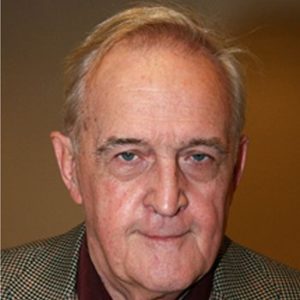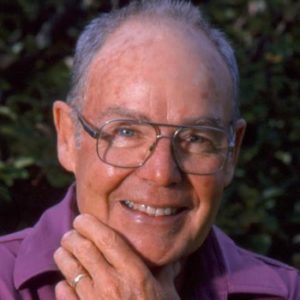
Douglas Coleman

Jeffrey Friedman
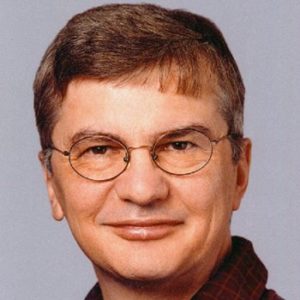
Napoleone Ferrara
The Art of Science
Opening remarks by Joseph Goldstein
An expanded version of these remarks originally appeared in Nature Medicine.
How to win a Lasker? Take a close look at Bathers and Bulls
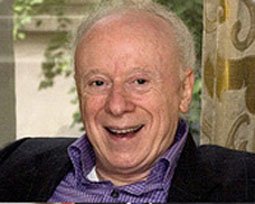 Some of our most influential scientists have spent much of their spare time moonlighting as amateur philosophers. Famous scientists like the physiologist Claude Bernard, the biochemist Hans Krebs, the immunologist Peter Medawar, the physicist Richard Feynman, and the molecular biologist James Watson have offered all sorts of guidance on how to become more creative and make groundbreaking discoveries. There is no shortage of advice to the young scientist. The challenge is to distinguish the good advice from the not-so-good advice.
Some of our most influential scientists have spent much of their spare time moonlighting as amateur philosophers. Famous scientists like the physiologist Claude Bernard, the biochemist Hans Krebs, the immunologist Peter Medawar, the physicist Richard Feynman, and the molecular biologist James Watson have offered all sorts of guidance on how to become more creative and make groundbreaking discoveries. There is no shortage of advice to the young scientist. The challenge is to distinguish the good advice from the not-so-good advice.
- Ask the right question — Claude Bernard (1813-1878)
- Select the right mentor, one who can teach you how to be ruthless in criticizing your own work — Hans Krebs (1900-1981)
- Be passionate and obsessive about solving a problem — Peter Medawar (1915-1987)
- Be audacious and take risks, or as Richard Feynman (1918-1988) would say “Have your tea with lemon and cream”
- Avoid boring people — James Watson (1928- )
Not a bad list, but it’s not a foolproof formula for a scientific breakthrough that will win you a Lasker Award or a Nobel Prize. In my view, the single most useful piece of advice on how to achieve scientific greatness comes from the British scientist Godfrey H. Hardy (1877-1947), who dominated the field of mathematics in the early 1900s. To the pure mathematician, Hardy’s major achievement was in analytic number theory. To the biomedical scientist, Hardy is best known for formulating the Hardy-Weinberg Law, a basic principle of population genetics that is used to calculate gene frequencies.
“Cerebral chills” and “intellectual kicks”
In 1940, Hardy wrote a short essay on how to become a great mathematician. The essay had a provocative title: “A Mathematician’s Apology.” It received a rave review in The Spectator by the British novelist Graham Greene, who began by saying that Hardy had nothing to apologize for, for “I know of no writing — except perhaps Henry James’s introductory essays — which conveys so clearly and with such an absence of fuss the excitement of the creative artist.”
In his essay, Hardy likened mathematics to art, believing that the best mathematicians were those who approached their work like an artist rather than as a practitioner: “The mathematicians’ patterns, like the painters, . . . . must be beautiful.” Hardy’s idea of mathematical beauty was a piece of science that gave him a “cerebral chill” and an “intellectual kick” — one that combined the qualities of significance, generality, and unexpectedness. Significance, generality, and unexpectedness are the very same qualities that produce chills and kicks in members of the Lasker Jury.
If we follow the logic of Hardy, this purest of all pure mathematicians, then the best way to learn how to become a great scientist is to learn how great artists — artists like Matisse and Picasso — create their magic. And this brings me to two of their magical works, Matisse’s Bathers by a River and Picasso’s The Bull. Bathers and Bull owe their power to two essential ingredients — radical thinking and fearless experimentation.
Matisse’s Bathers
In the first 20 years of his career, Henri Matisse was best known for his vibrant paintings of exotically dressed young women, lush interiors, and pastoral landscapes. By the beginning of the 20th century, he had become the undisputed master of rich bright colors as seen in famous works like The Red Room, The Dance, and The Woman with a Hat. Then, in an astonishing 5-year period between 1909 and 1913, he abruptly abandoned his signature decorative style and invented a new type of modern art — one that in its day was radical both in its imagery and its technique.
With his new method of construction, Matisse would begin a painting with a realistic scene that he eventually reduced to a near abstract image by reworking the surface of the canvas like a sculptor rather than like a painter. After appling multiple layers of paint to the canvas, he would scrape, scratch, and incise the surface and then reapply more thick paint, repeating the scraping, painting, and incising over and over again until the perfect sculptural depth and forms of the image emerged. The stimulus for this profound change in Matisse’s thinking was the realization that he was losing his top-dog position in the Parisian avant-garde to Picasso, who at that time was inventing Cubism. As Samuel Johnson famously said, “there is nothing like the prospect of a hanging to concentrate the mind.”
The supreme example of Matisse’s new approach to painting is the monumental Bathers by the River. When Matisse started Bathers in 1909, it was intended as one of three large decorative panels commissioned for the drawing room of a wealthy Moscow collector. The design for the original version of Bathers was a idyllic landscape scene rendered in pastel colors depicting five nude women, two of whom were luxuriating in a waterfall (Fig. 1a). The Moscow patron bought two of the panels, but turned down Bathers — too much nudity for his grand staircase. The timing of this rejection coincided with the beginning of Matisse’s new sculptural approach to painting. In a frenzy of experimentation over the next eight years, from 1909 to 1917, Matisse repeatedly reworked Bathers, revising the composition more than 20 times, as documented with the latest technologies of X-radiography, infrared reflectography, and stereoscopic microscopy. Conservatory experts at the Art Institute in Chicago have distinguished 17 different states of color in the painting that were left over from earlier versions.
The finished version of Bathers by a River (Fig. 1b), which hangs today at the Art Institute, looks very different from the 1909 original (Fig. 1a). One of the five bathers has been removed, and the remaining four have been transformed from fleshy, languid women to abstract, totem-like figures, which are segmented in four vertical bands of dark green, black, grey, and light blue that define the spatial contours of the painting. But most striking of all, the blue and white waterfall of the original has now been transformed into the vertical black band, onto which a white snake crawls.
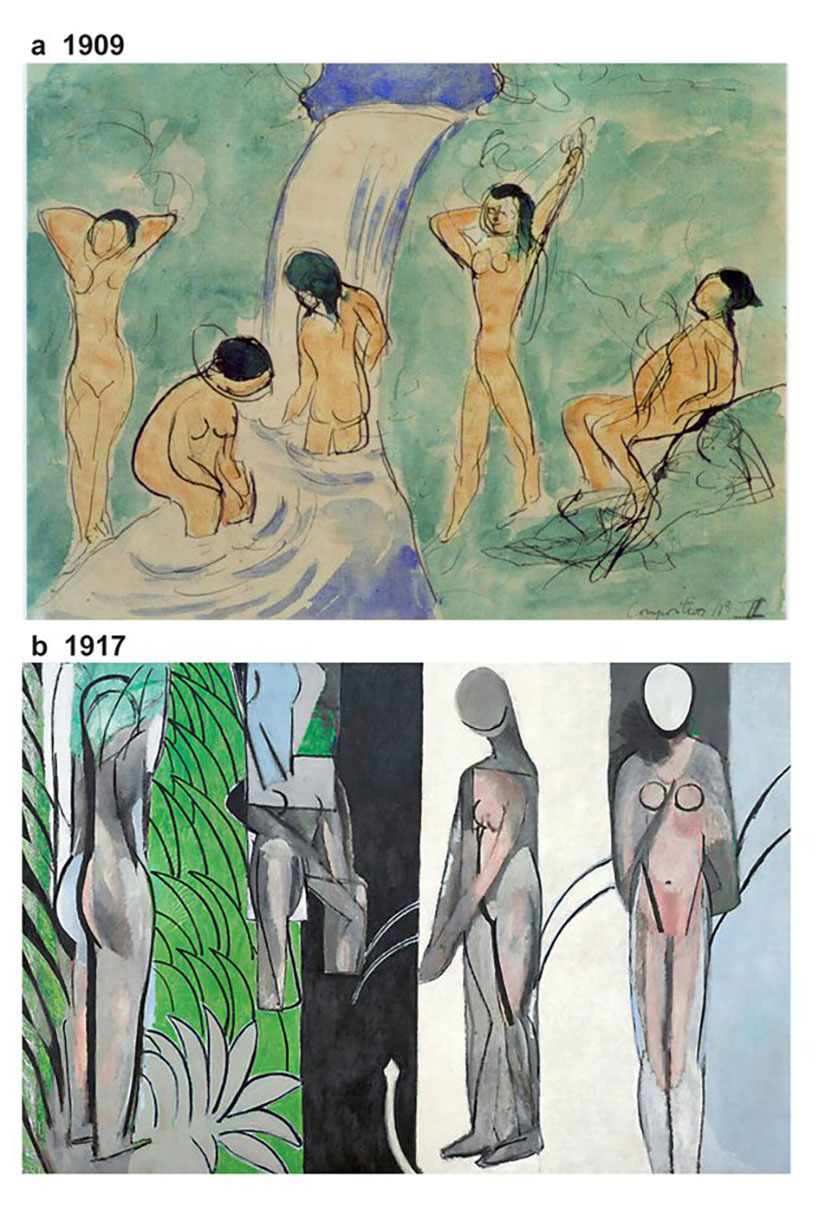
Figure 1. Matisse’s Bathers: from start to finish — 8 years. (a) Composition No. II. 1909. Watercolor on paper, 21.9 x 29.5 cm. The State Pushkin Museum of Fine Arts. Moscow. This watercolor became the starting design for what eventually became Bathers by a River. (b) Bathers by a River. 1917. Oil on canvas, 260 x 392 cm. The Art Institute of Chicago.
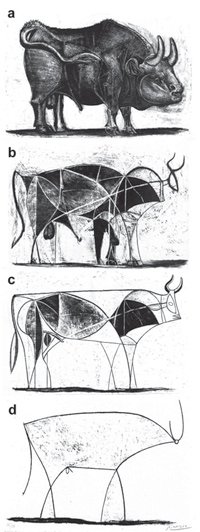
Figure 2. Picasso’s Bulls: from start to finish — 45 days. This montage shows four of the 11 progressive states of composition of Picasso’s The Bull done between Dec. 5, 1945 and Jan. 17, 1946. Lithographs on stone, 33.2 x 43.2 cm. Printer: Mourlot, Paris. (a) State III; (b) State VI; (c) State VIII; (d) State XI. Museum of Modern Art, New York City.
Before Bathers was acquired by the Art Institute in 1953, it hung during the 1930s and 1940s in the lobby of an art gallery on East 57th Street in Manhattan. The eminent art critic Clement Greenberg claims that he was so mesmerized by Bathers and saw it so often that he could copy it by heart. Bathers also influenced many budding young artists like Jackson Pollack, Wilhelm de Kooning, Mark Rothko, and Barnett Newman. Perhaps more than any other single painting, Bathers was the bridge that connected the representational art of Cézanne with the full-blown abstract expressionism of Jackson Pollock and his contemporaries.
Picasso’s Bull
Like Matisse, Pablo Picasso was a radical thinker and a fearless experimenter. But, there was one profound difference between them: Picasso produced his art with prodigious speed. He worked night and day, creating as many as three objects every day of his life. Picasso’s advice to the young painter was explicit: if you want to do something, just do it — and when you do it, take the bull by the horns and don’t let go until you’ve done what you wanted to do. Not surprisingly, bulls — the iconic emblem of macho Spain — became one of Picasso’s favorite subjects, second only to his wives and mistresses.
To celebrate the end of World War II and the liberation of Paris, Picasso engaged in a nonstop orgy of lithographic printmaking in which he used the bull to illustrate how the artist turns reality into abstraction. Over a 45-day period and with a single plate of stone, Picasso produced a suite of 11 prints, each depicting the bull in a different body form. In the third lithographic plate, the bull emerged as a beefy, plump, well-nourished beast (Fig. 2a). Picasso then reworked the plate to create eight new versions of his original bull, with the bull getting leaner (Fig. 2b) and leaner (Fig. 2c) in each successive version. He was essentially deconstructing the bull by carving away slices of its beef from the stone lithographic plate. After each slice, Picasso would look at his assistants and exclaim: “Look, we ought to give this bit to the butcher. The housewife could say: ‘I want that piece or this one’.” In the last version, plate number 11 (Fig. 2d), the bull was reduced to its essential elements: the body was an outline of only several lines, the head the size of an ant, and the genitalia the size of a pea. Picasso’s 45 days of goring the bull captured the essence of the beast in as minimal an image as possible — a vivid example of radical thinking and fearless experimentation.
Like Matisse and Picasso, this year’s Lasker Awardees are imaginative thinkers and fearless experimentalists. Their scientific accomplishments fulfill G. H. Hardy’s three axioms for scientific greatness — significance, generality, and unexpectedness. Their accomplishments also illustrate the beauty and power of uniting two disparate ideas into a conjoined state, as aptly illustrated by a sculpture entitled Conjoined, by the contemporary American artist Roxy Paine (Fig. 3). Conjoined is a large (40 ft tall by 45 ft wide) hand-wrought stainless steel sculpture of two trees whose branches are united in mid-air. Each branch of one tree joins imperceptibly with a branch from the other tree in such a way that it is unclear where one tree begins and the other ends.
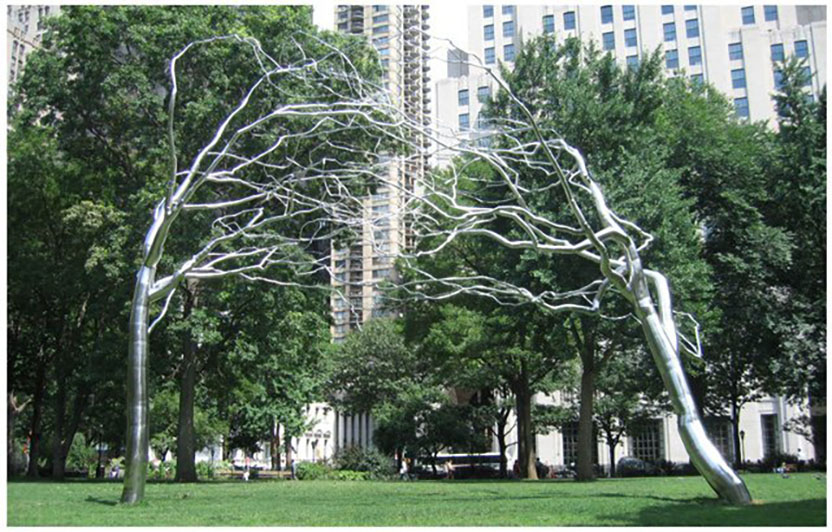
Figure 3. Roxy Paine. Conjoined. 2007. Hand-wrought stainless steel. 40 x 45 ft. This sculpture of two Conjoined trees was exhibited at Madison Square Park in New York City in 2007. This complex work is fabricated from 7000 metal pipes and rod elements of 30 different diameters that are assembled by cutting, bending, welding, grinding and polishing. The artist is represented by the James Cohan Gallery in New York City.
After lunch, Michael Brown, a Lasker Jury veteran of 15 years, will tell you how conjoining the blood circulation of two different strains of mice produced a revolution in obesity research. Richard Lifton, who has been a Jury member for 7 years — almost, but not quite long enough for Veterans benefits — will tell you how conjoining the twin disciplines of obstetrics and biotechnology produced the first effective treatment for macular degeneration. And Lucy Shapiro, a newcomer to the Jury and unquestionably the most attractive and charming of our lot, will tell you how conjoining self-confidence at the bedside with self-critical evaluation at the bench produced an international statesman of biomedical science.
Now, please conjoin your knife and fork and enjoy your lunch.
Jury
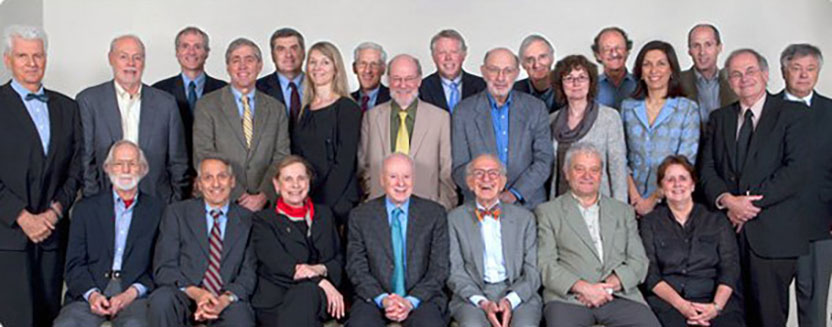
2010 Lasker Medical Research Awards Jury
First Row, left to right: J. Michael Bishop, University of California, San Francisco ● Donald Ganem, University of California, San Francisco ● Lucy Shapiro, Stanford University ● Joseph Goldstein, Chair of the Jury, University of Texas Southwestern Medical Center ● Eric Kandel, Columbia University ● Paul Nurse, The Rockefeller University ● Diane Mathis, Harvard University
Second Row, left to right: Günter Blobel, The Rockefeller University ● Phillip Sharp, Massachusetts Institute of Technology ● Richard Lifton, Yale University ● Cornelia Bargmann, The Rockefeller University ● Robert Horvitz, Massachusetts Institute of Technology ● Stanley Cohen, Stanford University ● Titia de Lange, The Rockefeller University ● Huda Zoghbi, Baylor College of Medicine ● Gregory Petsko, Brandeis University
Third Row, left to right: Marc Tessier-Lavigne, Genentech ● Craig Thompson, University of Pennsylvania Cancer Center ● Stuart Kornfeld, Washington University ● Jack Dixon, Howard Hughes Medical Institute ● Martin Raff, University College London ● Harold Varmus, National Cancer Institute ● Jeremy Nathans, Johns Hopkins School of Medicine ● Michael Brown, University of Texas Southwestern Medical Center
Ceremony
-
The 2010 Lasker Laureates: David Weatherall, Napoleone Ferrara, Douglas Coleman, and Jeffrey Friedman.
-
Lasker Foundation Chair Alfred Sommer, and President Maria Freire, present Douglas Coleman with his Award.
-
Purnell and Joan Choppin with Robert Roeder (Lasker, 2003) and Harvey Alter (Lasker, 2000).
-
Richard Woychick, Francis Collins, and Nancy Wexler (Lasker, 1993).
-
Alfred Sommer (Lasker, 1997), Jeremiah Barondess, and Marguerite Lederberg.
-
Jury Chairman Joseph Goldstein spoke about the deep connections between art and science.
-
Mike Overlock, David Weatherall, and James Fordyce.
-
Faith Hochberg and Eric Rose.
-
Marc Tessier-Lavigne, Gary Ruvkun (Lasker, 2008), and Craig Thompson.
-
Alfred Sommer, David Weatherall, and Lucy Shapiro.
-
Sherry Lansing, Joseph Goldstein (Lasker, 1985), and Charles Sawyers (Lasker, 2009).
-
The 2010 Lasker Winners, joined by Maria Freire, Alfred Sommer, and Joseph Goldstein.
-
Elias Zerhouni and Purnell Choppin.
-
Roger Glass, Zhi-Nan Chen, and Tim Shi.
-
Roger Bingham and Michael Brown.
-
Deeda Blair, Barbara Brody, and Jordan Gutterman.
-
Solomon Snyder (Lasker, 1978) and Michael Brown.
-
Laura Chang, Larry Altman, and Chris Brody.
-
Susan Lasker Brody and Gerald Fischbach.
-
George Noon with Kern and Marnie Wildenthal.
-
Mark Hochberg and Martin Tolchin.
-
Gunter Blobel (Lasker, 1993), Anne Fordyce, and Sam Silverstein.
-
Jeffrey Friedman receives his award from Alfred Sommer and Maria Freire.
-
Jeffrey Friedman's acceptance remarks.
-
Jordan Gutterman, Sharotka Simon, Lucy Shapiro, and Michael Brown (Lasker, 1985).
-
Richard Lifton and Donald Seldin.
-
Alfred Sommer, Napoleone Ferrara, Maria Freire, and Joseph Goldstein.
-
David Weatherall's acceptance remarks.
-
Ariel Pablos-Mendez and Laurie Garrett.
-
Anthony Adams, Kari Alitalo, and Rakesh Jain.
-
Douglas Coleman and Maria Freire.
-
Michael Callahan, Sherry Kidd, Larry Donoso, Sandra Blackwood, and Hugo Marx.
-
Douglas Coleman, Michael Brown, and Joseph Goldstein.
-
Nicholas Lydon (Lasker, 2009) and James Fordyce.
-
Antonio Gotto, Sylvia Karasu, and Donna de Varona.
-
Herbert Pardes and Joan Choppin.
-
Jordan Gutterman, David Hirsh, and Neen Hunt.
-
Lasker Laureates and scholars gathered before the Awards ceremony to discuss careers in medical research.
-
Maria Palopoli, Kathryn Wellen, and Daniel Denning.
